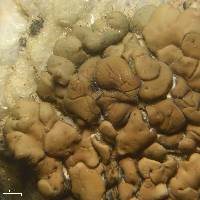
Consortium of Lichen Herbaria
- building a Global Consortium of Bryophytes and Lichens as keystones of cryptobiotic communities -
- Home
- Search
- Images
- Species Checklists
- US States: O-Z >
- US National Parks
- Central America
- South America
- US National Parks
- Southern Subpolar Region
|
|
|
|
Family: Acarosporaceae
[Acarospora peliocypha (Wahlenb.) Th. Fr., moreLichen squamulosus Schrad., Parmelia peliocypha Wahlenb., Parmelia squamulosa Ach.] |
Nash, T.H., Ryan, B.D., Gries, C., Bungartz, F., (eds.) 2007. Lichen Flora of the Greater Sonoran Desert Region. Vol 3. Thallus: areoles becoming subsquamulose, indeterminate, overall up to 1-2 cm wide areoles: very irregularly shaped, sometimes semi-lobate, 1-4 mm in diam. and up to 1.3 mm thick, radiating outward forming an orbicular to asymmetric pattern; rim: down-turned, concolorous with surface upper surface: uniformly creamy to yellow-brown, dull, very convex, smooth or fissured, epruinose lower cortices: paraplectenchymatous, (30-)50-60(-70) µm thick; syncortex: less than 10 µm thick or absent; eucortex: with a thin pale yellow upper layer and a hyaline lower layer with distinct cellular lumina in water, 3-5 µm thick algal layer: even medulla: very white, prosoplectenchymatous, obscure in water lower surface: narrow, corticated, dark attachment: broad , thickening to elevate the areole (gomphate) but without forming a stipe Apothecia: usually one, round, up to 1mm in diam. disc: becoming darker brown than squamule, very rough usually with sterile interascal plectenchyma forming ridges, circles, or an umbo, not extending into fertile hymenium but upon its surface; rare specimens lack any interascal plectenchyma parathecium: c. 20 µm thick, expanding to ±60 µm at surface of disc, usually forming a ring around most apothecia concolorous with thallus and higher than surface of disc epihymenium: clear to light brown below sterile tissue on disc surface, not readily distinguished from hymenium, and hyaline in K, c. 15 µm thick hymenium: dark yellow-brown above, hyaline below, 90-130 µm tall (hyper-ascal plectenchyma of umbo and ridges up to ±130 µm above disc surface and dark yellow brown but hyaline in K); paraphyses: ±2 µm wide at base expanding at summit to ±3 µm wide subhymenium: hyaline and hard to distinguish from hypothecium, c. 30 µm thick; hypothecium: c. 20 µm thick asci: clavate, matching height of hymenium, often not fully developed, swelling to 30 µm wide when spores mature, 100+-spored ascospores: hyaline, simple, ellipsoid, 4-5 x ±2.1 µm Pycnidia: not observed Spot tests: UV-, cortex C+ red, KC+ red Secondary metabolites: gyrophoric acid (major), lecanoric acid (minor), 3-hydroxygyrophoric acid (trace), methyl lecanorate (trace) (HPLC, J.A. Elix, pers comm.). Substrate and ecology: on granite at middle elevations from 1000-2000 m, often on desert side of mountains World Distribution: Europe, Greenland, Canada , with localized distribution in eastern California (Inyo and Mono Cos.) and New Mexico Sonoran distribution: Arizona and southern California. Notes: Some creamy yellow specimens of A. bullata could be mistaken for A. peliscypha, but Sonoran A. bullata does not have well-developed structures of hyper-ascal plectenchyma. Sonoran specimens of A. peliscypha were better developed than European specimens examined and matched upper size limits of European descriptions. |
Powered by Symbiota




















